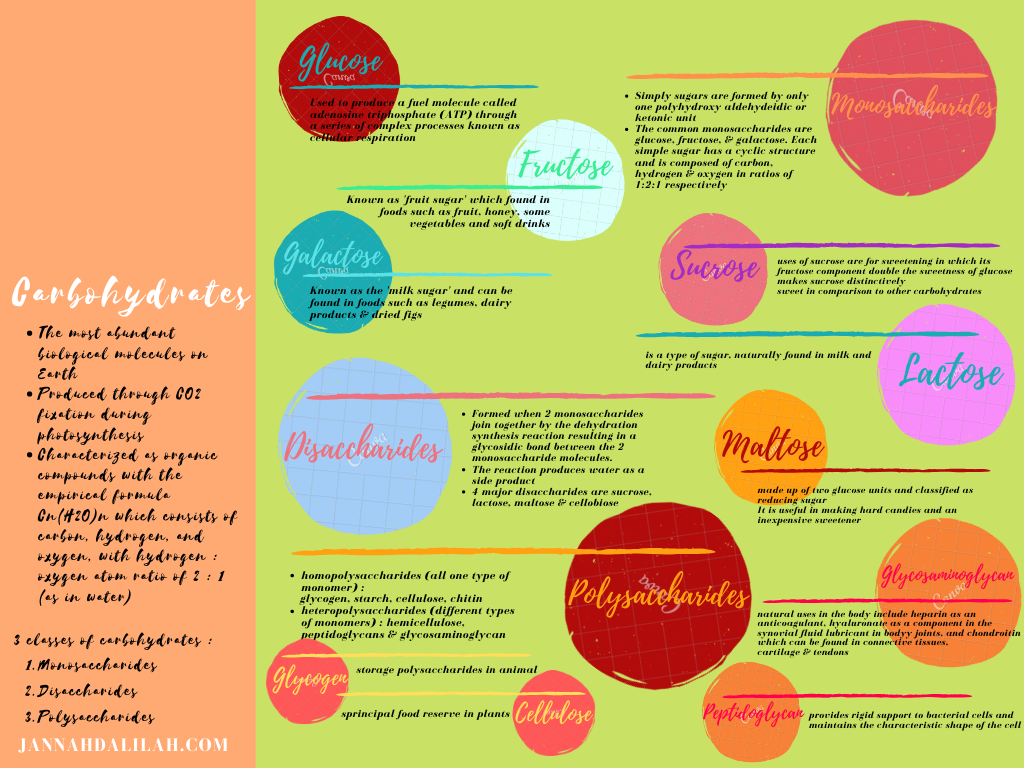In studying the topic of carbohydrates which taught by Dr. Mickey Vincent, I can describe the various types of carbohydrates and its function in our daily life. Carbohydrates
is the most abundant biological molecules on Earth. Carbohydrates is produced
through CO2 fixation during photosynthesis. Carbohydrates characterized as organic
compounds with the empirical formula Cn(H2O)n
which consists of carbon, hydrogen, and oxygen, with hydrogen : oxygen atom
ratio of 2 : 1 (as in water). There are three classes of carbohydrates which
are monosaccharides, disaccharides, and polysaccharides.
First
class is monosaccharides which
is simply sugars are formed by only one polyhydroxy aldehydeidic or ketonic
unit. Monosaccharides are
classified according to the number of carbon such triose (C3H6O3), tetrose
(C4H8O8), pentose (C5H10O5), hexose (C6H12O6), heptose (C7H14O7) and octose
(C8H16O8). The common monosaccharides are glucose, fructose, and
galactose. Each simple sugar has a cyclic structure and is composed of carbon,
hydrogen and oxygen in ratios of 1:2:1 respectively. The most
abundant monosaccharide is D-glucose, also called dextrose. Glucose in the
blood is taken up into our body's cells and used to produce a fuel molecule
called adenosine triphosphate (ATP) through a series of complex processes known
as cellular respiration. Fructose also known as 'fruit sugar' which found in
foods such as fruit, honey, some vegetables and soft drinks. Galactose is a
component of lactose which is known as the 'milk sugar' and can be found in
foods such as legumes, dairy products and dried figs. Dextrose 5% in water is
injected into a vein through an IV to replace lost fluids and provide
carbohydrates to the body. Dextrose 5% in water is used to treat low blood sugar
(hypoglycaemia), insulin shock, or dehydration (fluid loss).
Next, the
second class is disaccharides which are formed when two monosaccharides
join together by the dehydration synthesis reaction resulting in a glycosidic
bond between the two monosaccharide molecules. The reaction produces water as a
side product. The four major disaccharides are sucrose, lactose, maltose and cellobiose.
Sucrose provides our body with the energy required to perform
physical and mental functions. Our body breaks
down foods such as sucrose and starch
into fructose and glucose during digestion. The fructose and glucose are
metabolized by our body to release energy to your cells. Moreover, sucrose also contributes to a major element in confectionery,
desserts and cooks purpose. The uses of sucrose are for sweetening
in which its fructose component, that has almost double the sweetness of
glucose, makes sucrose distinctively
sweet in comparison to other carbohydrates. It can also act as a food
preservative when used in sufficient concentrations. Lactose is a type
of sugar, naturally found in milk and dairy products.Lactose-free milk has the same nutrient profile as
regular cow's milk, so we still get the same vitamins, minerals, calcium, and
protein, without the discomfort. Studies have found that a diet which includes
low-fat dairy products may lower our blood pressure and decrease our chances of
developing type 2 diabetes. In the intestine, lactose is transformed by
lactase, an enzyme, into glucose and galactose, both simpler sugars, which are
used by our body for energy and various functions. Maltose is a disaccharide that is made up of two glucose
units and classified as reducing sugar. It is useful in making hard candies and
an inexpensive sweetener. Maltose is found in starchy grains, vegetables and
fruits. It is useful as a low-cost sugar source in the form of high-maltose
corn syrup. Cellobiose is a
disaccharide with the formula C12H22O11. Cellobiose, a reducing sugar, consists
of two β-glucose molecules linked by a β(1→4) bond. Cellobiose can be used as
an indicator carbohydrate for Crohn's disease and malabsorption syndrome.
The third class is
polysaccharides. There two types of
polysaccharides which are homopolysaccharides (all one type of monomer) such as
glycogen, starch, cellulose, chitin and heteropolysaccharides (different types
of monomers) for instance hemicellulose, peptidoglycans and glycosaminoglycan.
Starch is made of polymers of α-D-glucose
units and known as the principal food reserve in plants whereas glycogen is the
storage polysaccharides in animal. Chitin is
the main component of the cell walls of fungi, the exoskeletons of arthropods
such as crustaceans, crabs, lobsters and shrimps and insects. Cellulose is the principal food reserve in plants
while hemicellulose function as supporting material in the cell wall. Glycosaminoglycan's
natural uses in the body include heparin as an anticoagulant, hyaluronate as a
component in the synovial fluid lubricant in body joints, and chondroitin which
can be found in connective tissues, cartilage and tendons while peptidoglycan
provides rigid support to bacterial cells and maintains the characteristic
shape of the cell. Peptidoglycans also allows bacterial cell to withstand media
of low osmotic pressure, such as water.
I create a mind map on the topic of CARBOHYDRATES to make it easier for me to refer back in the future.
I create a mind map on the topic of CARBOHYDRATES to make it easier for me to refer back in the future.

No comments:
Post a Comment